Class 10 Science Biology Chapter 8 MCQ With Answers
Biology Class 10 Chapter 8 MCQs On How do Organisms Reproduce?
How Do Organisms Reproduce Class 10 MCQ Question 1.
Fertilisation is the process of:
(a) transfer of male gamete to female gamete.
(b) fusion of nuclei of male and female gamete.
(c) adhesion of male and female reproductive organs.
(d) the formation of gametes by a reproductive organ.
Answer:
(b) Fusion of nuclei of male and female gamete.
Explanation: Fertilization is the fusion of nucleus of male and female garnets to form a single cell called as zygote. Fertilization occurs in sexually reproducing organisms.
Related Theory:
During sexual mode of reproduction germ cells (gametes) of two individuals need to fuse together. It can happen by either of the following:
External release of germ cells from body of an individual as seen in angiospermic plants, frog, fish etc. This is known as external fertilization.
Internal transfer of germ cells by physical contact between male and female organisms as in mammals. This is called internal fertilization.
Reproduction Class 10 MCQ Question 2.
Characters that are transmitted from parents to offsprings during reproduction show:
(a) OnLy similarities with parents
(b) Only variations with parents
(c) Both similarities and variations with parents
(d) Neither similarities nor variations
Answer:
![]()
How Do Organisms Reproduce MCQ Question 3.
Choose the correct statement(s) on budding in yeast from the following:
(I) A parent cell divides into two or more daughter ceLLs and here the parent identity is Lost.
(II) In this the elongated nucleus divides to form two or more daughter nucLei.
(III)A bud arises from a particular region on a parent body.
(IV)After detaching from the parent body the bud grows into a new independent individual.
(a) (I) only
(b) (III) only
(c) (II) and (III) only
(d) (III) and (IV) only
Answer:
(d) (III) and (IV) only
Explanation: Yeast reproduces asexually by the process of budding in which a bud arises from a particular region on a parent body. And after detaching from the parent body the bud grows into a new independent individual.
Statements I and II are for binary and multiple fission respectively.
Class 10 Science Chapter 8 MCQ Question 4.
The number of chromosomes in parents and offsprings of a particular species remains constant due to:
(a) Doubling of chromosomes after zygote formation
(b) Halving of chromosomes during gamete formation
(c) Doubling of chromosomes after gamete formation
(d) Halving of chromosomes after gamete formation
Answer:
Class 10 How Do Organisms Reproduce MCQ Question 5.
In the following figure, different stages of binary fission in amoeba are depicted, which are not in the proper sequence
Answer:

The correct sequence is
(a) (II), (III), (IV), (I) (b) (I), (II), (IV), (III)
(c) (III), (IV), (II), (I) (d) (I), (III), (IV), (II)
[CBSE 2017]
Ans. (a) (II), (III), (IV), (I)
Explanation: The correct sequence of the different stages of binary fission in amoeba is:
(II) Parent amoeba cell.
(III) Duplication of the genetic material and elongation of the nucleus.
(IV) Nuclear division and constriction in cytoplasm
(I) Formation of two daughter amoeba cells.
MCQ Of How Do Organisms Reproduce Question 6.
In Rhizopus, tubular thread-like structures bearing sporangia at their tips are called:
(a) Filaments
(b) Hyphae
(c) Rhizoids
(d) Roots
Answer:
![]()
How Do Organisms Reproduce Class 10 MCQ With Answers Question 7.
Select the correct statements for the process of budding in yeast:
(I) A bud arises from a particular region on a parent body.
(II) A parent cell divides into two daughter cells, here the parent identity is lost.
(III) Before detaching from the parent body a bud may form another bud.
(IV) A bud when detaches from the parent body grows into a new individual.
(a) (I), (II) and (III)
(b) (II), (III) and (IV)
(c) (III), (IV) and (I)
(d) (IV), (I) and (II)
Answer:
Reproduction MCQs Class 10 Question 8.
Slides of binary fission in Amoeba and budding in yeast were given for observation to a group of students. Some of the observations reported by the group are given below:
(I) Cytokinesis was observed in the yeast cell.
(II) A chain of buds were observed in Amoeba.
(III) Single cell of Amoeba and single cell of yeast were undergoing binary fission and budding respectively.
(IV) Elongated nucleus was dividing to form two daughter nuclei in Amoeba.
The correctly reported observations are:
(a) (I) and (II)
(b) (II) and (III)
(c) (III) and (IV)
(d) (I) and (IV)
Answer:
(c) (III) and (IV)
MCQ On Reproduction In Organisms Pdf Class 10 Question 9.
Which of the following statements are true for flowers?
(I) Flowers are always bisexual
(II) They are the sexual reproductive organs
(III) They are produced in all groups of plants
(IV) After fertilization they give rise to fruits
(a) (I) and (IV)
(b) (II) and (III)
(c) (I) and (III)
(d) (II) and (IV)
Answer:
(d) (II) and (IV) i.e. they are the sexual reproductive organs and after fertilization they give rise to fruits
Explanation: Flowers are the sexually reproductive organs of a plant and a fertilized flower give rise to fruit.
Class 10 Reproduction MCQ Question 10.
During adolescence, several changes occur in the human body. Mark one change from the following associated with sexual maturation in boys:
(a) loss of milk teeth
(b) increase in height
(c) cracking of voice
(d) weight gain
Answer:
MCQ Reproduction Class 10 Question 11.
Which among the following statements are true for sexual reproduction in flowering plants?
(I) It requires two types of gametes.
(II) Fertilisation is a compulsory event.
(III) It always results in the formation of zygote.
(IV) Offsprings formed are clones.
(a) (I) and (IV)
(b) (I), (II) and (IV)
(c) (I), (II) and (III)
(d) (I), (II) and (III)
Answer:
MCQ On How Do Organisms Reproduce Class 10 Question 12.
Characters transmitted from parents to offspring are present in:
(a) Cytoplasm
(b) Ribosome
(c) Golgi bodies
(d) Genes
Answer:
(d) Genes
Explanation: Genes are the unit of heredity DNA that determine genetic characters in an organism.
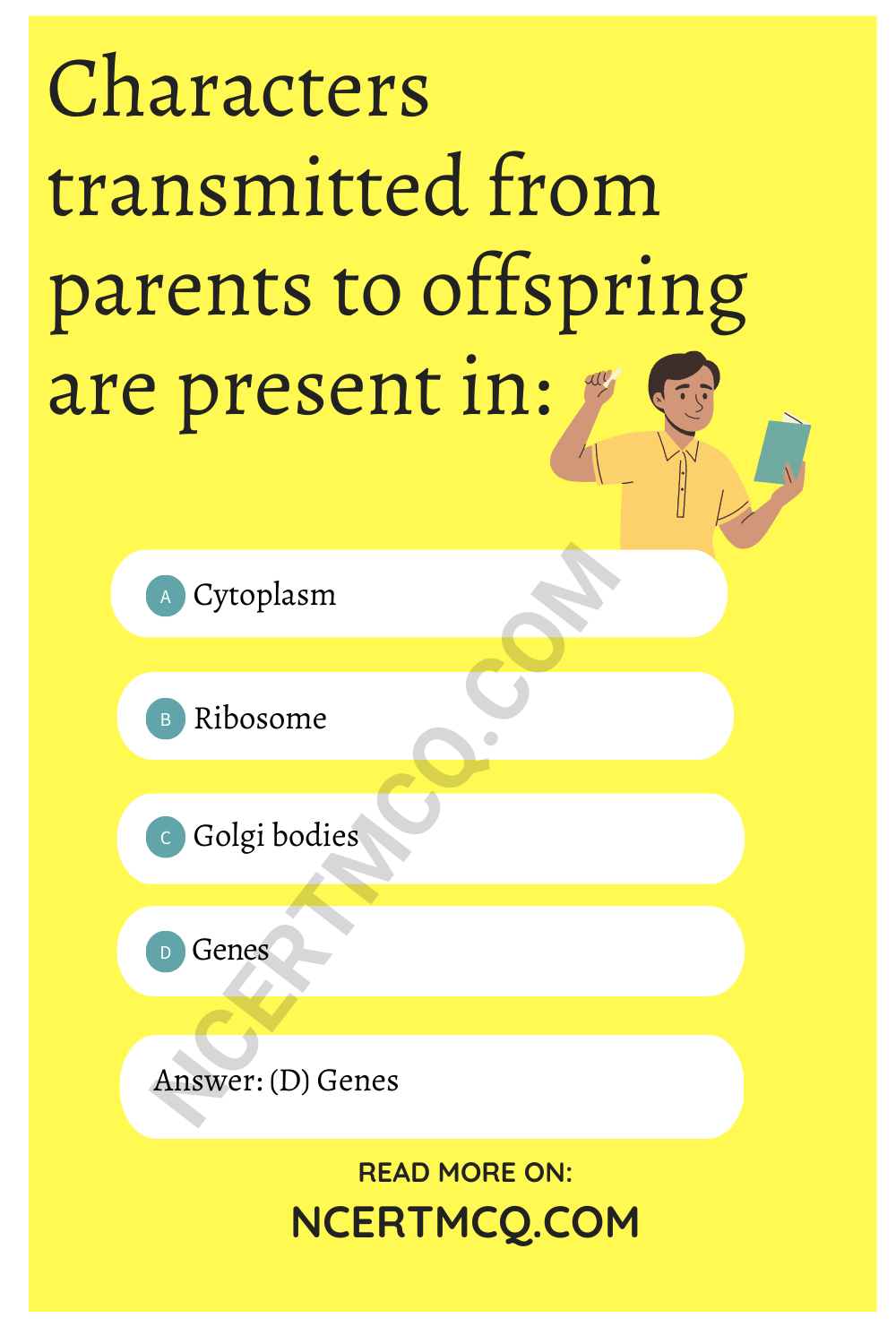
![]()
MCQ On How Do Organisms Reproduce Question 13.
Semen which contains millions of sperms also contains secretions of seminal vesicle and prostrate gland (accessory glands). It makes the tranport of sperms easier and provide nutrition to sperms.
Correct sequence of organs in the male reproductive system for transport of sperms is:
(a) Testis → vas deferens → urethra
(b) Testis → ureter → urethra
(c) Testis → urethra → ureter
(d) Testis → vas deferens → ureter
Answer:
(a) Testis → vas deferens → urethra
Explanation: Testis produces sperms or germ cells. The sperms formed are delivered through the vas deferens which unites with a tube coming from the urinary bladder. The urethra thus forms a common passage for both the sperms and urine.
How Do Organisms Reproduce Class 10 MCQ Pdf Question 14.
Reproduction is essential for living organisms to order to:
(a) Keep the individual organism alive
(b) Fulfill their energy requirements
(c) Maintain growth
(d) Continue the species generation after generation
Answer:
Ch 8 Science Class 10 MCQ Question 15.
Which one of the following permanently marks the end of menstrual cycle in females?
(a) Menarche
(b) Menopause
(c) Ovulation
(d) Pregnacy
Answer:
Question 16.
Which among the following diseases is not sexually transmitted?
(a) Syphillis
(b) Hepatitis
(c) HIV-AIDS
(d) Gonorrhoea
Answer:
(b) Hepatitis
Explanation: Hepatitis is not a sexually transmitted disease. It is a water-borne viral disease.
Question 17.
The sketch of a dicotyledonous seed is shown below.
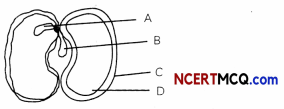
The correct labelling for parts A, B, C and D iri proper sequence is
(a) radicle, plumule, cotyledon, seed coat.
(b) radicle, plumule, seed coat, cotyledon.
(c) plumule, radicle, cotyledon, seed coat.
(d) plumule, radicle, seed coat, cotyledon
Answer:
Question 18.
Which of the following is not the part of female reproductive system?
(a) ovary
(b) fallopian tube
(c) uterus
(d) vas deferens
Answer:
(d) vas deferens
Explanation: Vas deferens is part of male reproductive system.
![]()
Question 19.
Select the statements that are incorrect about reproduction in human beings.
(I) When a girl is born, the ovaries already contain thousands of mature eggs.
(II) One egg is produced every month by one of the ovaries.
(III) The egg is carried from the ovary to the womb through oviduct.
(IV) The two oviducts unite into an elastic bag-like structure known as the cervix.
(a) Both (I) and (III)
(b) Both (I) and (IV)
(c) Both (II) and (III)
(d) Both (II) and (IV)
Answer:
Question 20.
Study the diagram given below of male reproductive organ and select the row containing incorrect information.
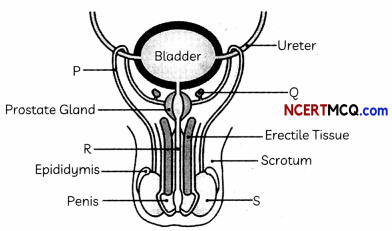
| Name of Part | Function |
| (a) P is Vas deferens | Transport sperms |
| (b) Q is Seminal vesicle | Provide fluid medium to sperms |
| (c) R is ureter | Passage for sperms |
| (d) S is Testis | Formation of sperms |
Answer:
Question 21.
Study the figure below and identify the row containing incorrect information.
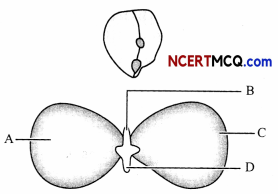
| Part Name | Function |
| (a) A is Cotyledon | It is the future plant |
| (b) B is Plumule | It is the future shoot |
| (c) C is Seed coat | It is the outer covering of the ovule |
| (d) D is Radicle | It is the future root |
Answer:
(a) Part Name: A is cotyledon; Function: It is the future plant
Explanation: A is cotyledon and is the food store of the future plant.
Question 22.
Study the figure showing parts of a flower and identify the correct statements.
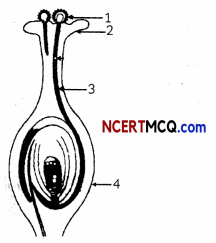
(I) Part labeled 1 is the pollen grain and contains the male germ cell.
(II) Part labelled 3 is the stigma on which the pollen grains land.
(III) The male germ cell travels through the pollen tube (part labelled 3) after fertilization.
(IV) Part labelled 4 is the ovary which contains the female germ cells.
(a) Both (I) and (III)
(b) Both (II) and (IV)
(c) Both (I) and (III)
(d) Both (I) and (IV)
Answer:
![]()
Question 23.
Identify the incorrect statement from among the following statements for unisexual flowers.
(a) They always possess stamen and pistil
(b) They possess either stamen or pistil
(c) They show cross pollination
(d) Unisexualflowers posessing only stamens cannot produce fruits
Answer:
(a) They always possess stamen and pistil
Explanation: Unisexual flowers contain either stamens or carpels. Bisexual flowers contain both male and female reproductive organs stamen and carpel.
Question 24.
The part where fertilization occurs in human females is:
(a) cervix
(b) vagina
(c) uterus
(d) oviduct
![]()
Question 25.
The table below lists the organs/parts of human reproductive system and their functions. Identify the row containing incorrect information.
| Part/ Organ of Reproductive system | Function |
| (a) Prostate gland and seminal vesicles | Production of fluid to provide a medium for sperms. |
| (b) Testis | Secretes the hormone that regulates formation of sperms. |
| (c) Uterus | Provides nutrition from mother’s blood to embryo. |
| (d) Fallopian tube | Carries egg from ovaries to the womb |
Answer:
(c) Part/Organ of Reproductive system: Uterus; Function: Provides nutrition from mother’s blood to embryo.
Explanation: The embryo gets nutrition from the mother’s blood with the help of a special tissue called placenta which is a disc embedded in the uterine wall and contains villi on the embryo’s side of the tissue.
Assertion Reasoning questions Class 10 Science Chapter 8
For the following questions two statements are given-one labeled Assertion (A) and the other labeled Reason (R). Select the correct answer to these questions from the codes (a), (b), (c) and (d) as given below:
(a) Both (A) and (R) are true and (R) is correct explanation of the assertion.
(b) Both (A) and (R) are true but (R) is not the correct explanation of the assertion.
(c) (A) is true but (R) is false.
(d) (A) is false but (R) is true.
Question 26.
Assertion (A): Variation is useful for the survival of species over time.
Reason (R): Populations of organisms fill well-defined places in the ecosystem, using their ability to reproduce.
Answer:
(b) Both (A) and (R) are true but (R) is not the correct explanation of the assertion.
Explanation: Although populations of organisms fill well-defined pLaces in the ecosystem, using their ability to reproduce, the consistency of DNA copying during reproduction. Reproduction is important for the maintenance of body design features. Reproduction is linked to the stability of populations of species.
However, variation is useful for the survival of species over time as niches can change drastically but only those organisms will be able to survive which have some variations in them.
Question 27.
Assertion (A): All multi-cellular organisms can divide cell by cell.
Reason (R): Many multi-cellular organisms are not simply a random collection of cells.
Answer:
(d) (A) is false but (R) is true
Explanation: All multi-cellular organisms cannot simply multiply cell by cell as they are not just a random collection of cells. Specialized cells are organized as tissues and tissues are organized into organs, which occupy definite positions in the body. Multi-cellular organisms, therefore, need to use more complex ways of reproduction.
Question 28.
Assertion (A): Vegetative propagation makes possible propagation of plants that have lost the capacity to produce seeds.
Reason (R): New plants are developed from seeds in vegetative propagation.
Answer:
Question 29.
Assertion (A): Pollen grains are produced by all flowers.
Reason (R): Stamen is the male reproductive part of a flower and produces pollen grains.
Answer:
(d) (A) is false but (R) is true
Explanation: All flowers do not produce pollen grains as flowers may be unisexual when it contains either stamens or pistil or bisexual when it contains both stamens and pistil. Stamen is the male reproductive part of a flower and produces pollen grains that are yellowish in colour.
Question 30.
Assertion (A): Testes in human males are located outside the abdominal cavity in scrotum.
Reason (R): Testes secrete the male sex hormone testosterone.
Answer:
(b) Both (A) and (R) are true but (R) is not the correct explanation of the (A)
Explanation: The testes in human males are located outside the abdominal cavity in the scrotum as sperm formation requires a lower temperature than the normal body temperature. Testes secrete the male sex hormone testosterone which regulates the formation of sperms and brings about changes in appearance seen in boys at the time of puberty.
![]()
Question 31.
Assertion (A): The human embryo gets implanted in the fallopian tube.
Reason (R): Embryo gets nutrition from the mother’s blood with the help of special tissue called the Placenta.
Answer:
Question 32.
Assertion (A): A basic event in reproduction is the creation of a DNA copy.
Reason (R): The DNA in the cell nucleus is the information source for making proteins.
Answer:
(Competency Based Questions (CBQs))
Question 1.
Rahul left a slice of bread in his tiffin box by mistake. As his schools had closed for Diwali vacations, he forgot to take the tiffb ox out. When he opened his tiffin box after about 6 to 7 days, he observed black growth on the bread slice and also that the slice smelt very bad.
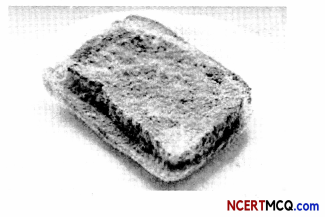
Identify the organism, the thread like structures seen on the bread and the mode of reproduction of the organism.
Answer:
The organism seen on the bread is Rhizopus and the thread like structures are the hyphae of the bread mould. The mode of reproduction in Rhizopus is by spore formation.
Question 2.
The reproductive parts of angiosperms are located in the flower. The different parts of a flower are sepals, petals, stamens and carpels. Stamens and carpels are the reproductive parts of a flower which contain the germ-cells.
The flower may be unisexual (papaya, watermelon) when it contains either stamens or carpels or bisexual (Hibiscus, mustard) when it contains both stamens and carpels. Stamen is the male reproductive part and it produces pollen grains that are yellowish in colour.
Carpet is present in the centre of a flower and is the female reproductive part.

(A) Where are the plant’s sex organs located?
Answer:
Plant’s sex organs are located in the flower.
(B) What is the function of a flower?
Answer:
The function of a flower is to produce male and female gametes and to ensure that fertilisation will takes place to make new seeds for the reproduction of plant.
(C) Where is the male and female gametes formed in flowering plants?
Answer:
(D) What changes take place in the flower after fertilisation which lead to the formation of seeds and fruit?
Answer:
The fertilised egg divides several times to form an embryo within the ovule which develops a tough coat around it and is gradually converted into a seed. The ovary of the flower develops and becomes a fruit with seeds inside it.
![]()
Question 3.
Asexual reproduction in starfish takes place by fission or through autotomy of arms. In fission, the central disc breaks into two pieces and each portion then regenerates the missing parts. In autotomy, an arm is shed with part of the central disc attached, which continues to live independently as a “comet”, eventually growing a new set of arms. Although almost all sea stars can regenerate their limbs, only a select few sea star species are able to reproduce in these ways.
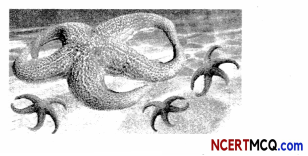
Offspring formed by asexual method of reproduction have greater similarity among themselves because:
(I) Asexual reproduction involves only one parent
(II) Asexual reproduction does not involve gametes
(III) Asexual reproduction occurs before sexual reproduction
(IV) Asexual reproduction occurs after sexual reproduction
(a) (I) and (II)
(b) (I) and (III)
(c) (II) and (IV)
(d) (III) and (IV)
Answer:
Question 4.
The growing size of the human population is a cause of concern for all people. The rate of birth and death in a given population will determine its size. Reproduction is the process by which organisms increase their population.
The process of sexual maturation for reproduction is gradual and takes place while general body growth is still going on. Some degree of sexual maturation does not necessarily mean that the mind or body is ready for sexual acts or for having and bringing up children.
Various contraceptive devices are being used by human beings to control the size of population.
(A) List two common signs of sexual maturation in boys and girls.
Answer:
Common signs of sexual maturation in boys and girls: Hair growth in armpits and the genital area between the thighs, which also becomes dark in colour.
Thinner hair appear on legs and arms as well as on the face.
Pimples begin to develop as skin becomes oily.
Become conscious and aware of their own bodies and those of others in new ways.
Related Theory
Prenatal sex determination is misused by people who do not want a particular child. Pre-conception and Pre-Natal Diagnostic Techniques (PC PNDT) Act, 1994 is an act of the Parliament of India enacted to stop female foeticides and arrest the declining sex ratio in India.
(B) What is the result of reckless female foeticide?
Answer:
(C) Which contraceptive method changes the hormonal balance of the body?
Answer:
The contraceptive method is chemical method (Taking Pills orally) changes the hormonal balance of the body.
Explanation: By taking oral pills, the hormonal balance of the body changes and eggs are not released and fertilization does not occur. Since they cause change in hormonal balance can cause side effects like nausea, headache, weight gain, mood changes etc.
Related Theory
The population size is actually population density, the number of individuals per unit area. The size of human population is a cause for concern for many people because increase in population size makes is harder to improve everybody’s standard of living.
(D) Write two factors that determine the size of a population.
Answer:
Question 5.
Bees are one of the most important animals which help in the pollination process. Bees hit plants because they give them an essential source called nectar. There are many flowering plants which are fertilized by insects like bees, and without them, many of our plant population of the planet would decline as there would be no pollination, so it’s clearly known the relevance of these pollinators.Bees transport seeds from one flower to another, pollinating these plants so that it can develop and provide food. The pollen grains travel through the pollen tube to the ovary.
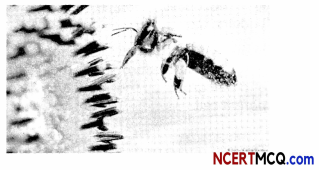
The length of pollen tube depends on the distance between:
(a) Pollen grain and upper surface of stigma
(b) Pollen grain on upper surface of stigma and ovule
(c) Pollen grain in anther and upper surface of stigma
(d) Upper surface of stigma and lower part of style
Answer:
(b) Pollen grain on upper surface of stigma and ovule
Explanation: After the pollen lands on a suitable stigma, it has to reach the female germ-cells which are in the ovary. For this, a tube grows out of the pollen grain and travels through the style to reach the ovary.
Hence, length of the pollen tube depends on the distance between the pollen grain on the upper surface of stigma and ovule.
![]()
Question 6.
Pre-Conception and Pre-Natal Diagnostic Techniques (PCPNDT) Act, 1994 is an Act of the Parliament of India enacted to stop female foeticides and arrest the declining sex ratio in India. The act banned prenatal sex determination. This process began in the early 1990 when ultrasound techniques gained widespread use in India. There was a tendency for families to continuously produce children until a male child was bom. Social discrimination against women and a preference for sons have promoted female foeticide in various forms skewing the sex ratio of the country towards men.
(A) Why is child sex-ratio declining at an alarming rate in India?
Answer:
The child-sex ratio is declining at an alarming rate because of preference in Indian societies for a male child and reckless female foeticides.
(B) How can unwanted pregnancies be terminated?
Answer:
Unwanted pregnancies can be terminated by surgery.
(C) What is contraception?
Answer:
(D) Write names of any two contraceptive methods.
Answer:
Question 7.
When Sunidhi’s niece was born, she observed that something resembling a cord was tied near the baby’s naval. Her uncle explained to her that it was the umbilical cord, which is a tube that connects the baby to her mother during pregnancy.
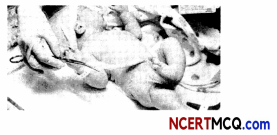
Which one of the following best describes the function of the umbilical cord?
(a) feeds the embryo with digested substances
(b) conveys nutrients and wastes to and from the embryo respectively
(c) removes waste matter from the embryo to the mother’s blood
(d) supplies oxygenated blood from the mother to the embryo
Answer:
(b) conveys nutrients and wastes to and from the embryo, respectively.
Explanation: The exchange of nutrients, oxygen and waste products between the embryo and the mother’s body takes place through the umbilical cord.
Related Theory
Umbilical cord is connected to a special tissue called placenta which is a disc like structure embedded in the uterine wall.
It contains villi on the embryo’s side of the tissue and blood spaces are present on mother’s side, which surround the villi.
Villi provide large surface area for glucose and oxygen to pass from the mother to the embryo.
Question 8.
(A) Observe the above graph and select the correct statements.
(I) The mean fitness of asexual progeny is adapted optimally for a particularly narrow niche.
(II) The mean fitness of sexual progeny is adapted optimally for a particularly narrow niche.
(III) Asexual progeny may survive when niche changes.
(IV) Sexual progeny have a higher chance of survival when niche changes.
(a) Both (I) and (III)
(b) Both (I) and (IV)
(c) Both (II) and (IV)
(d) Both (II) and (III)
Answer:
(b) Both (I) and (IV)
Explanation: The mean fitness of an asexual clone of organisms is adapted optimally for a particularly narrow niche. They are perfect in the current environment, but, once the condition changes, the entire population may suddenly become extinct. Sexual reproduction can produce a wider range of sub-optimally adapted types. Some may not be able to survive under the current environment (an example is the genetic diseases in humans). However, an ecological disaster that eliminates the asexual progeny will not have as severe an impact on the sexual progeny, because of the diversity of genotypes.
(B) Reason, why paramecium decides for sexual reproduction, is:
(a) It can produce more number of progenies.
(b) Progenies can be considered to be clones of their parents
(c) It leads to genetic variations
(d) Asexual reproduction is unreliable.
Answer:
(c) It leads to genetic variations
Explanation: The reason why the paramecia decide to sexual reproduction is that they need to create “genetic variations” to increase their chance of survival under a harsh condition. In order to do so, two paramecia of compatible mating types exchange parts of their genetic materials and rearrange their DNA to create genetic variations. As a result, the offsprings of sexual reproduction have different genetic DNA sequences compared to their parents. On the other hand, the daughter cells generated from binary fission have identical genome like their parent cell. We call them “clones”.
(C) Select the row containing incorrect information.
| Asexual Reproduction | Sexual Reproduction |
| (a) Only one parent is involved | Involves two parents |
| (b) No production and hence no fusion of gametes | Involves production of gametes and their fusion |
| (c) Requires meiotic division followed by mitotic division | Requires only mitotic division. |
| (d) Low genetic variability | High genetic variability |
Answer:
(c) Asexual Reproduction: Requires Meiotic division followed by Mitotic division; Sexual Reproduction: Requires only Nitotic division.
Explanation: Asexual Reproduction requires only mitotic cell division as no gametes are produced. Sexual reproduction requires meiotic division followed by mitotic division as first gametes are formed and then their fusion takes place.
(D) Which of the following organisms divide by binary fission?
(a) Amoeba and Plasmodium
(b) Paramecium and Plasmodium
(c) Paramecium and Amoeba
(d) Plasmodium and Leishmania
Answer:
(E) Four statements are given below on sexual reproduction. Identify the incorrect statement:
(a) Each new variation is made in a DNA copy that already has variations accumulated from previous generations.
(b) Two different individuals in a population would have quite different patterns of accumulated variations.
(c) Combining variations from two or more individuals would create new combinations of variants.
(d) Each new generation will end up having twice the amount of DNA that the previous generation had.
Answer:
![]()
Question 9.
Puberty is the time when boys and girls move through a series of significant, natural and healthy changes. These physical, psychological and emotional changes signal that they are moving from childhood to adolescence. Puberty starts when changes in their brain cause sex hormones to start being released in girls’ ovaries and boys’ testes. This usually happens around 10-11 years for girls and around 11-13 years for boys. But it’s normal for the start of puberty to range from 8-13 years in girls and 9-14 years in boys.
The graph below shows the average height of girls and boys up to the age of 18 years.
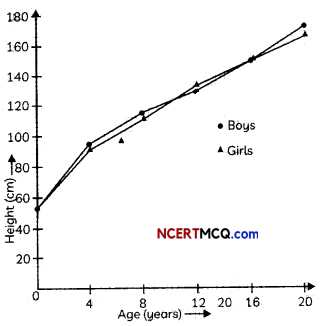
(A) Select the correct observations:
(I) During 8-12 gears, girls experience a sudden growth.
(II) During 12-16 gears, bogs experience sudden grown
(III) Bogs are alwags taller than girls of their age.
(IV) Growth in both bogs and girls stops after 16 gears.
(a) Both (I) and (II)
(b) Both (II) and (III)
(c) (I), (II) and (III)
(d) (I), (III) and (IV)
Answer:
(a) Both (I) and (II)
Explanation: We note that during 8-12 years, girls experience a sudden growth and have more height as compared to boys. This is because puberty occurs earlier in girls (10-12 years), so they grow rapidly during this phase.
During 12-16 years, boys experience sudden grown and their height becomes the same as girls. This is because puberty occurs later in boys (12-13 years) and they grow rapidly during puberty.
(B) The table below lists some changes observed in girls and bogs during pubertg. Select the row containing incorrect observation.
| Changes in Girls | Changes in Bogs |
| (a) Height increases verg quickly and earlier than in bogs | Height increases very quickly and Later than girls |
| (b) Voice pitch becomes higher | Voice pitch becomes Lower |
| (c) Shoulders become broad | Hips become broad |
| (d) Menstruation starts | Nocturnal emissions occur |
Answer:
(c) changes in Girls: Shoulders become broad;
Changes in Boys: Hips become broad
Explanation: Changes are seen in both boys and girls during puberty due to the secretion of testosterone hormone in boys and oestrogen in girls. The hips become broad in girls, whereas shoulders become broad in boys.
(C) The most rapid growth in girls takes place during:
(a) 0 – 4 gears
(b) 4 – 8 gears
(c) 8-12 gears
(d) 12 – 16 gears
Answer:
(a) 0 – 4 years
Explanation: The most rapid growth in girls takes place in 0-4 years as after that the rate of growth slows down. It again becomes fast from 8-12 years, when girls attain puberty.
(D) Significant spurt in height of bogs is seen during:
(a) 4 – 6 gears
(b) 6 – 8 gears
(c) 8-12 gears
(d) 12 – 16 gears
Answer:
(E) The slowest growth in height of girls is seen during:
(a) 0 – 4 gears
(b) 12 – 16 gears
(c) 8-12 gears
(d) 4 – 8 gears
Answer:
Question 10.
Family planning is about deciding how many children you choose to have and when you want to have them (timing of pregnancies and birth spacing). Spacing births allows the mother to recover physically and emotionally before she gets pregnant again, and faces the demands of pregnancy, birth and breast feeding. STIs including HIV/AIDS can also be prevented with correct and consistent use of condoms. Younger women (adolescents) can delay pregnancy until their bodies are mature and they are ready in terms of their life course. Older women (over 35) can prevent unwanted pregnancies that are often risky for their health and can lead to complications for both mothers and infants.
India’s 2011 census revealed a growing imbalance between the numbers of girls and boys aged 0-6 years, which may be due to increased prenatal sex determination with subsequent selective abortion of female fetuses. The sex ratio from the years 1961 to 2011 shows a very disturbing trend.
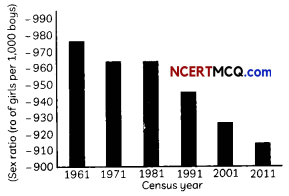
Distribution of the total population living in states with varying child sex ratios (girls per 1000 boys at ages 0-6 years), 1991, 2001, and 2011 is shown below.
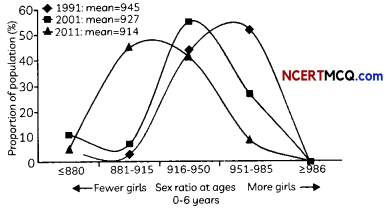
Mean national values for each of the censuses are shown. The vertical grey bar represents a natural sex ratio at birth of 950 – 975 girls per 1000 boys, where the distribution of child sex ratios at ages 0 – 6 years would be centred in the hypothetical absence of selective abortion of girls and equal girl and boy child mortality rates.
(A) Observe the graphs above and select the correct statements.
(I) The sex ratio from 1961 to 1981 was almost equal to the natural sex ratio at birth shown by vertical grey bar.
(II) Sex ratio in 2001 was less than the sex ratio in 2011.
(III) Sex ratio in 1991 was greater than the sex ratio in 2011.
(IV) The number of girls per 1000 boys of population has increased from 1991 to 2001.
(a) Both (I) and (II)
(b) Both (I) and (III)
(c) Both (II) and (III)
(d) Both (II) and (IV)
Answer:
(B) The main reason for the sex ratio as seen in the graph above is:
(a) Male foeticide
(b) Child labour
(c) Female Foeticide
(d) Child trafFcking
Answer:
(c) Female Foeticide
Explanation: Female foeticide is the illegal sex- selective abortion of female foetuses due to which child sex ratio is declining at an alarming rate.
(C) Which of the following are surgical methods for avoiding pregnancies?
(a) Oral pills
(b) Copper-T
(c) Blocking fallopian tube in females
(d) Blocking urethra in males.
Answer:
(D) The use of which contraceptive methods can prevent sexually transmitted diseases ?
(a) Condoms
(b) Oral pills
(c) Copper-T
(d) Surgical methods
Answer:
(a) Condoms
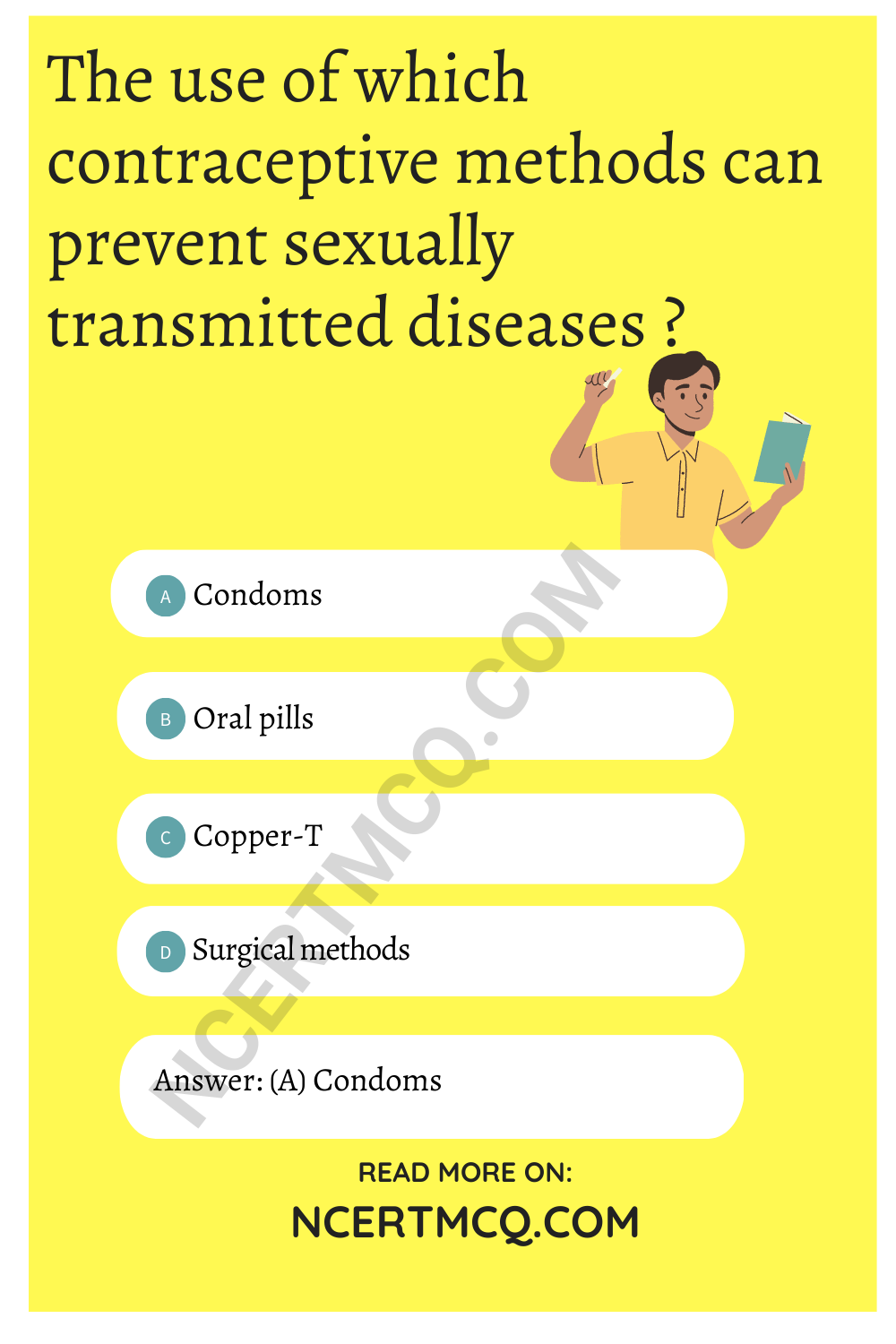
Explanation: As condoms are the only contraceptives that create a mechanical barrier between the partners sex organs during sexual intercourse, they can prevent sexually transmitted disesases.
(E) A list of few sexually transmitted diseases are given below along with their cause. Select the row containing incorrect information:
| Sexually Transmitted Disease Name | Cause |
| (a) Syphilis | Bacteria |
| (b) Gonorrhea | Bacteria |
| (c) AIDS | Virus |
| (d) Warts | Bacteria |
Answer:
![]()
Question 11.
Fluman reproduction is a form of sexual reproduction resulting in human fertilization. It typically involves sexual intercourse between a man and a woman. During sexual intercourse, the interaction between the male and female reproductive systems results in fertilization of the woman’s ovum by the man’s sperm. Offspring are produced by the fusion of gametes (sex cells) from each parent. Hence, the newly formed individual will be different from parents, both genetically and physically.
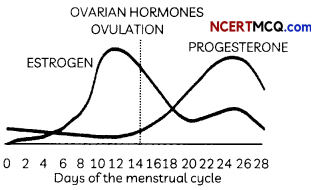
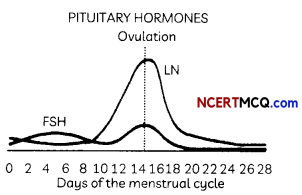
(A) Study the graphs above showing the levels of ovarian hormones and pituitary hormones in human females and select the correct statements.
(I) The level of oestrogen hormone increases in the first 12 days of the menstrual cycle.
(II) The level of LH secreted by the pituitary gland reaches a peak when ovulation takes place.
(III) The level of progesterone hormone decreases when ovulation takes place.
(IV) The level of FSH secreted by the pituitary gland is minimum when ovulation takes place.
(a) Both (I) and (III)
(b) Both (I) and (IV)
(c) Both (I) and (II)
(d) (I), (II) and (IV)
Answer:
(c) Both (I) and (II)
Explanation: The level of progesterone
hormone increases when ovulation takes place. The level of FSH secreted by the pituitary gland is maximum when ovulation takes place.
(B) The table below gives the differences between menopause and menarche.
Select the row containing incorrect information.
| Menopause | Menorche |
| (a) It is the end of menstruation in human females | It is the start of menstruation in humon females |
| (b) It occurs at around 45-50 years of age | It occurs at around 11-16 years of age |
| (c) It marks the end of reproductive phase of a female | It marks the beginning of the reproductive phase of a female |
| (d) There is an elevated level of oestrogen. | There is a decline in the Level of oestrogen |
Answer:
(d) Menopause : There is an elevated level of oestrogen; Menarche: There is a decline in the level of Oestrogen.
Explanation: During menopause, there is a decline in the level of oestrogen hormone as it indicates the end of reproductive phase of a women. Whereas, during menarche, which marks the beginning of the reproductive phase of women, there is an elevated level of oestrogen hormone
(C) Refer to the diagram of female reproductive system of humans given below:
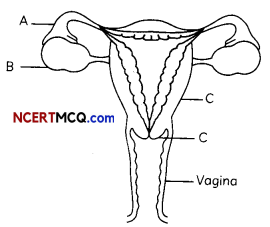
The correct labelling of parts A, B, C and D is:
(a) A: Oviduct, B: Ovary, C Uterus, D: Cervix
(b) A: Oviduct, B: Fallopian Tube, C: Ovary, D: Uterus
(c) A: Fallopian Tube, B: Uterus, C: Ovary, D: Cervix
(d) A: Oviduct, B: Ovary, C: Cervix, D: Uterus
Answer:
(a) A: Oviduct, B: Ovary, C: Uterus, D: Cervix
(D) The part of female reproductive system through which the uterus opens into the vagina is:
(a) Clitoris
(b) Cervix
(c) Scrotum
(d) Abdomen
Answer:
(E) The onset of reproductive age in human females is known as:
(a) Menstruation
(b) Menopause
(c) Menarche
(d) Ovulation
Answer:
![]()
Question 12.
Asexual reproduction is a type of reproduction that does not involve the fusion of gametes or change in the number of chromosomes. The offspring that arise by asexual reproduction from either unicellular or multicellular organisms inherit the full set of genes of their single parent. Asexual reproduction is the primary form of reproduction for single-celled organisms such as archaea and bacteria. Many eukaryotic organisms including plants, animals, and fungi can also reproduce asexually. In vertebrates, the most common form of asexual reproduction is parthenogenesis, which is typically used as an alternative to sexual reproduction in times when reproductive opportunities are limited.
(A) Which of the following observations are incorrect?
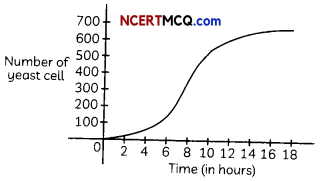
(I) The population of yeast grows slowly in the first 6 hours.
(II) The growth rate of yeast is fastest from t = 6 hours to t = 9 hours.
(III) The growth rate increases further from t = 9 hours to t = 12 hours.
(IV) The growth rate increases linearly from t = 2 hours to t = 12 hours.
(a) Both (I) and (III)
(b) Both (II) and (IV)
(c) Both (I) and (IV)
(d) Both (III) and (IV)
Answer:
(d) Both (III) and (IV)
Explanation: The growth rate decreases and levels off from t = 9 hours to t = 12 hours. The growth rate increases linearly from t = 2 hours to t = 12 hours.
(B) Select the row containing incorrect information:
| Name of Organism | Method of reproduction |
| Plasmodium | Fission |
| spirogyra | Regeneration |
| Rhizopus | Spore formation |
| Bryophyllum | Vegetative propagation |
Answer:
(C) The graph b.elow gives the observations of growth of bread mould (or mold) under different conditions:
A: Bread slices kept at normal room temperature
B: Bread slices kept in refrigerator C: Bread slices kept in freezer.
Select the incorrect statement after observing the graph.
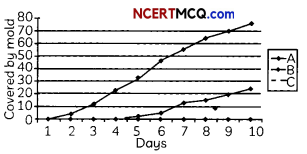
(a) Mould growth is fastest and covers 80% of the slice in 10 dags when kept at room temperature.
(b) Mould growth is slowest and covers 25% of the slice in 10 dags when kept at room temperature.
(c) Mould growth is slowest and covers 12% of the slice in 7 dags when kept in refrigerator.
(d) No mould growth observed for 10 dags when bread slice kept in freezer.
Answer:
(b) Mould growth is slowest and covers 25% of the slice in 10 days when kept at room temperature.
Explanation: Mould growth is the fastest at room temperature and covers about 80% of the slice in 10 days when kept at room temperature.
(D) The structures labelled A and B are:
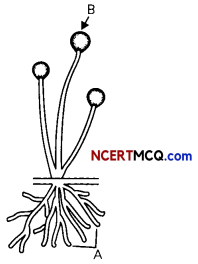
(a) A is hyphae and B is Spores
(b) A is root and B is Sporangium
(c) A is hgphae and B is Sporangium
(d) A is root and B is Spores
Answer:
(E) Select the correct statements for the process of budding in geast:
(I) A small bud arises as an outgrowth of the parent bodg.
(II) The parent cell divides into two daughter cells and hence the parental identitg is lost.
(III) The nucleus divides bg meiosis, one daughter nucleus passes into the bud and the other remains in the parent cell.
(IV) The bud either separates off from the parent cell or new bud appears before its separation from the parent cell resulting in the formation of branched or unbranched chain of buds.
(a) Both (I) and (II)
(b) Both (I) and (IV)
(c) Both (II) and (III)
(d) Both (III) and (IV)
Answer:
Very Short Answer Type Questions
Question 1.
Where is the zygote located in the flower after fertilisation?
Answer:
Zygote is Located inside the ovule which is present in the ovary.
Related Theory
After the pollen lands on a suitable stigma, it has to reach the female germ cells which are in the ovary. For this, a tube grows out of the pollen grain and travels through the style to reach the ovary. After fertilisation, the zygote divides several times to form an embryo within the ovule. The ovule develops a tough coat and is gradually converted into a seed. The ovary grows rapidly and ripens to form a fruit.
Question 2.
Give an example each of unisexual and bisexual flowers.
Answer:
An example of unisexual flower is papaya, water melon (write any one) and of bisexual flower is hibiscus, mustard (write any one).
Related Theory
Unisexual flowers contain either stamens or carpels. w Bisexual flowers contain both stamens and carpels. w Majority of the flowers are bisexual.
![]()
Question 3.
Name the organs producing sperms and ova respectively in humans.
Answer:
Question 4.
Name the method by which Spirogyra reproduces under favourable conditions. Is this method sexual or asexual?
Answer:
The method by which Spirogyra reproduces under favourable conditions is Fragmentation. This is an asexual mode of reproduction.
Question 5.
Name one organism which reproduces by:
(A) multiple fission
(B) binary fission
Answer:
Question 6.
Name the part of Bryophyllum where the buds are produced for vegetative propagation.
Answer:
Question 7.
What is meant by the term regeneration?
Answer:
Regeneration: The process of getting back a full organism from its body parts is called regeneration. The simple animals like Hydra and Planaria shows regeneration, i.e. if Hydra or Planaria somehow get cut into a number of pieces, then each body part can grow into a new complete organism.
![]()
Question 8.
How is reproduction in leishmania different from that in plasmodium, even though both are unicellular?
Answer:
Leishmania undergoes binary fission, whereas plasmodium reproduces through multiple fission.